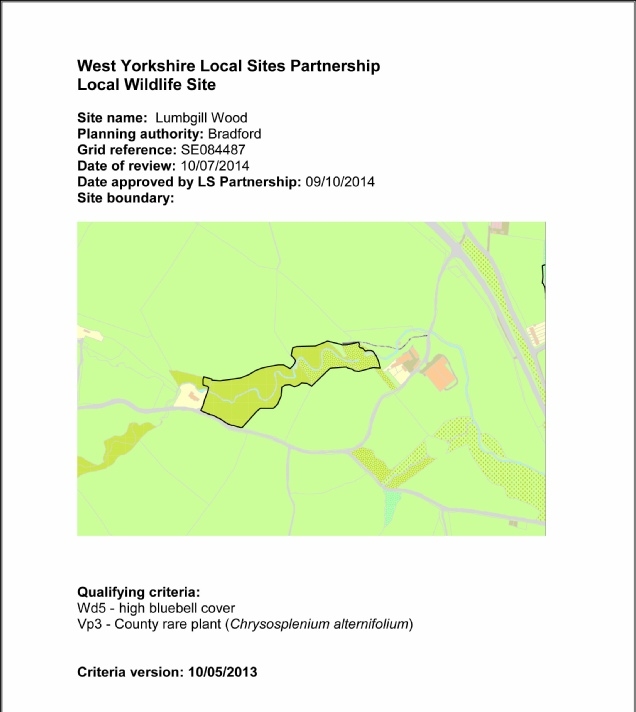Lumb Gill Wood
Bradford Wildlife Area – Evaluation Against Local Wildlife Site Criteria Site Name/ Code: Lumb Gill Wood BWA 029
Location: South-east of Addingham
Date of Survey: 02/05/2012 Surveyor: E. Skinner,
West Yorkshire Ecology
Grid Reference: SE084487 Site Area (Ha): 2.49 proposed LWS boundary (2.35 original BWA boundary)
Natural Area: Southern Pennines Public Access: path through one part of wood
NVC Communities: W8
Site Description
This woodland site is located to the south-east of the village of Addingham. It is surrounded by sheep grazed fields. Part of the southern boundary of the site adjoins to Cocking Lane. The western tip of the site is adjacent to a private house, while just to the east of the site is Lumb Gill Farm. Lumb Gill beck runs through the centre of the site, from west – east.
The majority of the site is covered by ancient replanted woodland. This is base-rich W8 woodland and is species rich. There is a wooded section directly adjoining the east of the site, which is also W8 and has been included in the proposed new boundary. The species present within the W8 include: frequent Acer pseudoplatanus, Quercus petraea, Fraxinus excelsior, Pinus sylvestris and Ulmus glabra in the canopy, occasional Corylus avellana and Ilex aquifolium in the shrub layer, and in the ground flora: frequent Hyacinthoides non-scripta and Holcus mollis, locally abundant Allium ursinum, occasional Anemone nemorosa, Athyrium filix-femina, Circaea lutetiana, Dryopteris affinis, D. diliatata, Galium aparine, Holcus lanatus, Melica uniflora, Oxalis acetosella, Poa trivialis, Rubus fruticosus, Silene dioica and Stellaria holostea, and locally frequent Ranunculus ficaria, Mercurialis perennis and Dactylis glomerata. Chrysosplenium oppositifolium was present at a few locations by the beck, and C. alternifolium was seen at one location by the beck.
There is a small section within the W8, which is more open and is marshy, with standing water present. Species here are: frequent Urtica dioica and Ranunculus ficaria, occasional Filipendula ulmaria, Silene dioica and Stachys sylvestris, and locally frequent Chrysosplenium oppositifolium.
The far western part of the site appears to now be part of the garden of the adjacent house. The trees have mostly been felled, although the woodland ground flora is still present over most of the area, including: Mercurialis perennis, Hyacinthoides non-scripta, Melica uniflora, Stellaria holostea and Viola riviniana. Some daffodils have been planted and there is a bench present.
Fauna recorded during the site visit were: singing males of robin, chaffinch, coal tit, chiffchaff, willow warbler, goldcrest and wren, a jay calling, a pair of pheasants, blue tits contact calling, and a garden warbler was seen. In the beck there were caddisfly nymphs, freshwater shrimp and pond skaters.


